| Author |
Message |
Luka Borscak

|
 Posted: Mon 13 Jun, 2011 6:45 pm Post subject: Brazil nut and related pommels, dating, Oakeshott vs Geibig Posted: Mon 13 Jun, 2011 6:45 pm Post subject: Brazil nut and related pommels, dating, Oakeshott vs Geibig |
 |
|
Since I'm a great fan of brazil nut and similar pommels, I have been reading lately what Oakeshott says about them in his books and how he dates them and I have found a few things rather unclear and maybe contradicting and some of the dating seems somewhat suspicious. So I wanted to ask you knowledgable people here what do you think and I would like to compare Oakeshott's dating and theories with Alfred Geibig's, but no Geibig's works are available for me so I need help with that... You will notice that I included cocked hat and type N and O in this topic too since they are obviously from the same family.
Here is what Oakeshott wrote about these pommels in the Archeology of Weapons:
Type A. In use frequently between c. 980 and 1120. More rarely up to c. 1200 on Type X swords.
Type B. Development of A. Popular between c. 1150-1250 on swords of Types XI and XII.
Type C. Development of Viking Type IX pommel. Popular c. 980-1100 on Type X swords.
Type D. Development of C and used between c. 1230-1280, generally on Type XII swords, but occasionally on Type XIII.
Type E. Same as D, another variety. Excellent example in hand of one of the Benefactors of Naumburg Cathedral (Conrad).
Type N. A rare type, obviously a bye-form of A, characterized by extreme breadth. The only two actual examples are a large war-sword (Type XIII) in Zurich and another, even larger, in Bucharest, found in Rumania. One of the Naumburg benefactors (Wilhelm von Cam-burg, fig. 107) has one on a short sword of Type XIV.
(Oakeshott dates a long griped type N from Romania in the Records of the Medieval Sword to 1100+...)
Type O. Curiously enough, nearly every sword (and there are many) carded by carved warrior-figures in the Cathedral of Freiburg has a pommel of this unusual form. Peter in the Garden of Gethsemane (fig. 108), SS. George and Sebastian (these two have long-gripped war swords), on the West Front and one of the sleeping guards of the Holy Sepulchre. All these figures were made about 1300. There is one pommel of this sort in the Maciejowski Bible. The only actual example I know of is on a sword which was in the Gimbel collection earlier in this century.
Here are a few sentences from the Sword in the Age of Chivalry:
Perhaps the most widely used pommel during the three centuries between c. 950 and c. 1250 is that which is generally known as the Brazil-nut form. It is perhaps also the most widely misunderstood, and the most often mis-dated. Therefore it may be expedient to begin with a detailed analysis of its development and image, treating it with a thoroughness not necessary in the case of other types.
It has been generally assumed that pommels of this form were in use during a period extending roughly from 1150 to 1250. There is, however, ample evidence clearly datable iconographical evidence to show that swords were furnished with them 200 years before this period, and that their use was general throughout the 11th and 12th centuries, particularly in Germany.
There are two other current misconceptions about the Brazilnut pommel that it developed from the so-called "Mushroom" form and eventually superseded it, and that the extent of the upward curvature of its lower edge is an indication of development and so of date. It has been stated by many authorities, in rather vague terms, that the Brazil-nut began to develop from the Mushroom form early in the 12th century, and that during the next 150 years the curvature of its base steadily grew until by about 1230 the upper edge was straight. The evidence shows conclusively that this was not so; both forms developed simultaneously in the early to middle 10th century, if not before; all the different varieties of the Brazil-nut, with a greater or lesser degree of curvature to their bases, were in use at the same time, alongside the more familiar lobated types of Viking pommel, and the variations in its shape were probably the result of chance or personal taste and not a matter of date at all.
And a bit later:
...The Brazil-nut pommel, on the other hand, continued in use for another 150 years. In the mid-12th century it began to develop a greater bulk, and in the later years of the same century several derivative forms appeared. The original shape of the 10th century was never quite lost, but the later types are easily recognizable by their much more massive appearance.
...It is not until we examine swords and monuments of the second half of the 12th century that we begin to see any noticeable change in the shape of the Brazil-nut pommel; at about that time it seems to have increased in depth or thickness at the base, so that it appears more conical when seen in profile. At the end of the century its height also began to increase until it became more like a peanut than a Brazil-nut (plate 4B).
Than he gives this picture with a text:

Another, made by Rodkerus of Helmeshausen in 1118, gives us several portrayals of X-type pommels.9 In the scenes which decorate the panels forming the sides and ends of this altar (the martyrdom of Paul and the baptism and death of Cornelius) several swords appear; all of their pommels are of the two X-types. In a group of three swords we can see (fig. 50) the three basic styles of the Brazil-nut form together the semi-circular one with a straight upper edge, the wide shallow form with upper and lower edges curved equally, and the short stubby type. This group alone is evidence enough that the semi-circular style was not a late development but was contemporary with all the others, including the Tea-Cosy form. I think there is no doubt that the differences in the shapes of these pommels drawn by Rodkerus are deliberate, not accidental; his literal treatment of the weapons he portrays is shown by the inscriptions with which he has decorated some of their blades. These inscriptions are not in the form of names, as is the case with some other drawings of the same period, but of various apparently meaningless combinations of upright lines, crosses and circles, and in one case an interlaced pattern (figs. 51a and b).
And later:
The second half of the 11th century brings us to the time where the Brazil-nut pommel begins to assume its final form, well exemplified by the ''Sword of St. Maurice" in Vienna. Its particular interest lies in its great beauty of form, its restrained and simple decoration and its perfect condition; it seems to have been untouched by the hand of time (plate 5B).
About cocked pommels:
It does not seem to have been quite so widely popular as the two X-types, though it was in use all through the 11th and 12th centuries and its development was parallel to that of the Brazil-nut type that is, it became more massive towards the end of the 12th century and remained in use down to the end of the 13th (fig. 57). As a matter of fact we find representations of the final forms of this type at a later date than the last of the X-type.
About merging of brazil nuts and cocked pommels:
Many of the large, developed Brazil-nut pommels of the mid-13th century seem to be a fusion of the two types: the Brazil-nut form no longer very like a Brazil nut tends to develop a slight concavity on its upper edges. The sword of Count Konrad at Naumburg is like this (fig. 61), and so is the pommel of an identical sword in the Royal Scottish Museum in Edinburgh whose finding-place is unfortunately not known (plate 12B).
In the Sword in the Age of Chivalry he also gives a slightly different datings and descriptions of his pommel types:
Type A.
A development of X, with the ends extended to form a very wide pommel, often as much as about 4" across. The earliest datable examples, clearly shown, are from an Arpad grave-find in Hungary of c. 1000, and a drawing (see fig. 8, p. 30 above) in an Ottonian manuscript picture datable between 98399.30 It probably remained popular until c. 1150 (plates 2A and 4C).
Type B.
This is bulkier and shorter and rounder than A, being a stouter version of X. Never very common, it seems mostly to be found on swords which on other evidence, i.e. blade inscriptions, can be dated between c. 1050 and c. 1150 (plate 4B).
Type C.
The pommel found on Viking swords of Type IX, like a cocked hat (Petersen's Type Y)31 is the immediate ancestor of C, which is of a similar hat-shape, but taller in the "crown" and now made in one piece (fig. 59). It is shown in art up to about 1150, merging after that time with:
Type D.
A stouter, bulkier version of C. Most frequently found in painting and sculpture between c. 1225 and c. 1275, and upon surviving swords which seem to be of the same date (see fig. 60, p. 90 above).
Type E.
Similar to D in bulk, it has straight or only slightly dished upper edges. Sometimes has a pronounced mid-rib (fig. 61). Contemporary with D (see plate 12B).
Type B1.
It bears some resemblance to the B pommels but with a straight lower edge. Good examples are in the Tower of London and the Historisches Museum in Berne (fig. 1).
Type N.
A pommel shaped like a boat. Examples are rare; there is one in the Zweizerische Landesmuseum in Zurich (Type XIIIa) and a second is in private hands in Rumania. This also is of Type XIIIa, a very large one. In art it is not quite so rare for instance, one of the Benefactors of Naumburg has one (Wilhelm von Camburg) on a short sword of Type XIV (see fig. 62, p. 92 above).
Type O.
Another rare type, but, curiously, nearly every sculptured figure of a military kind in the Cathedral of Freiburg has one of them. George and St. Sebastian, the sleeping guards at the Sepulchre, St. Peter in the Garden of Gethsemane and many more (figs. 65, 66, 67). Actual examples are almost unknown. There is a photograph of one in the catalogue of the Gimbel Collection. Even the never-failing Maciejowski Bible only shows one of them.
Now, I see some problems with his datings and classification. First, he gives different datings for different brazil nut types but at the same type says they were all contemporary and a matter of taste, not a date. Second, he has less different brazil nut types than Geibig and if Geibig has more precise dating for his types it could help to date some swords Oakeshott had problems dating. For example sword of St. Maurice in Turin has a type A pommel according to Oakeshott, but A type is Geibig's 15 and the pommels like on St. Maurice of Turin are 16v.II according to Geibig. Oakeshott wasn't sure for that sword, it might be early 12th as well as first half of 13th century according to him, but I think Geibig types could date it more securely since it has more detailed typology of such pommels.
Other problem is with the type N pommels. N family is rather limited sword family and they are probably made in a relatively short period, according to very good arguments from Marko Aleksić's article "Swords with pommels of type N", probably early 13th century. Oakeshott is obviously outdated about the dating of such swords since he guesses the type N sword from Romania in the Records of the Medieval sword to be about 1100 or a bit later... What does Geibig say about his type 17v.I which is Oakeshott's N?
Also he doesn't give any evolution theory for cocked hat pommel types.
So basically I would like people knowledgable about Geibig's typology and dating to post the dates of his types so that we could compare them to Oakeshott and see if we can maybe shed some light on the areas which are darker in Oakeshott's system. I only know about Geibig typology what can be read here on myArmoury featured article and that is not enough.
Also it would be great if people like Peter Johnsson and Craig Johnsson who have extensive experience with the originals could post some of their conclusions about these problems based on their research.
Any discussion, data or pictures on these types is welcome on this thread, it doesn't have to be Oakeshott / Geibig oriented.
|
|
  |
 |
Luka Borscak

|
 Posted: Mon 13 Jun, 2011 6:47 pm Post subject: Posted: Mon 13 Jun, 2011 6:47 pm Post subject: |
 |
|
For the end, I will post some pictures of the pommel types mentioned. Pictures are from here, myArmoury, Marko Aleksić's great article I mentioned, and some other web sites I don't remember any more.
Geibig typology:
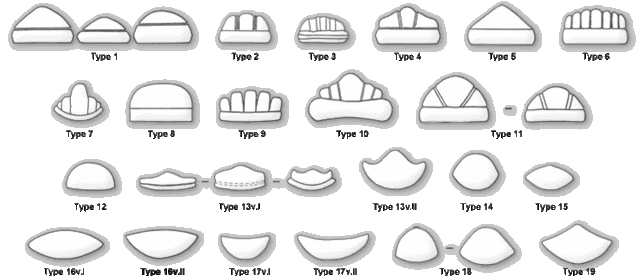
Oakeshott typology:
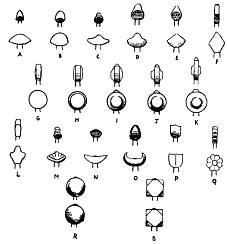
Oakeshott type A / Geibig type 15, 16v.I and 16v.II:

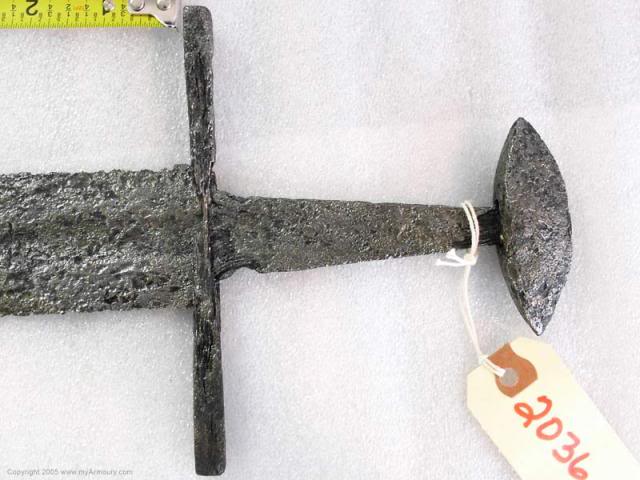



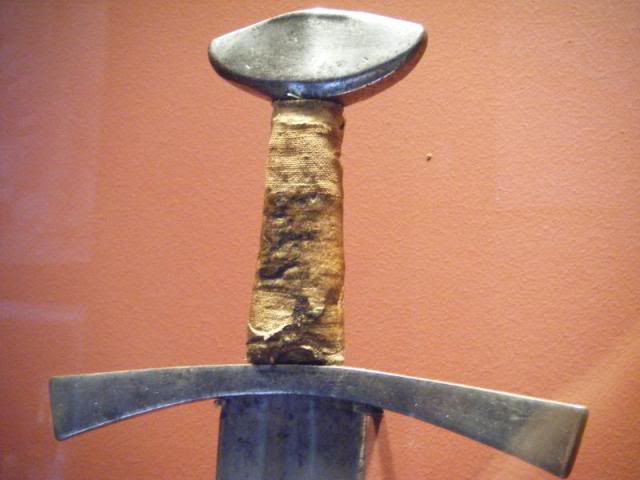
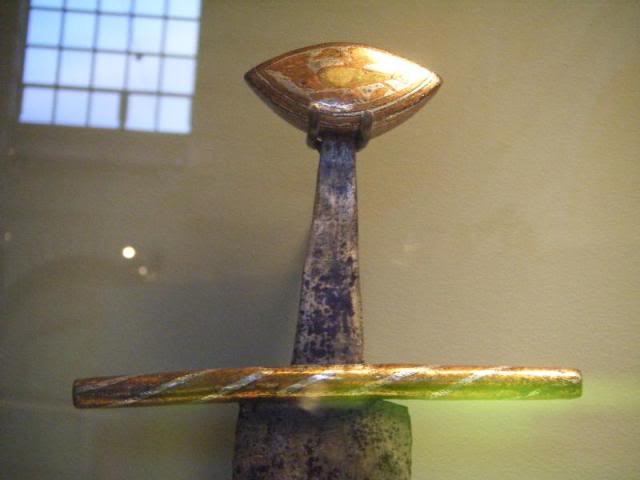
Oakeshott type B / Geibig type 14 and 18:




|
|
  |
 |
Luka Borscak

|
 Posted: Mon 13 Jun, 2011 6:49 pm Post subject: Posted: Mon 13 Jun, 2011 6:49 pm Post subject: |
 |
|
Oakeshott types C and D / Geibig types 13v.I and 13v.II:
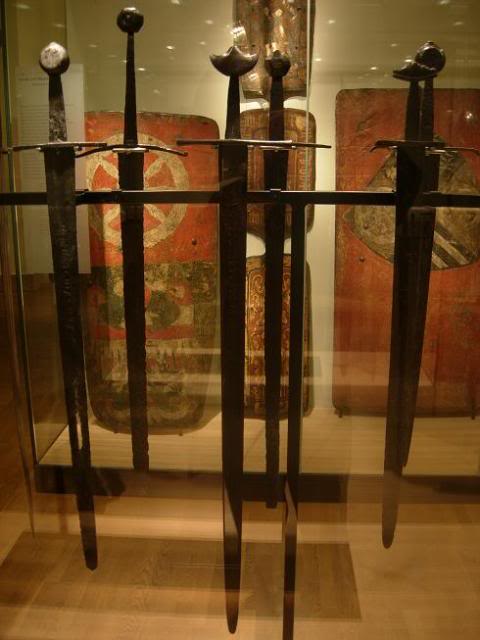

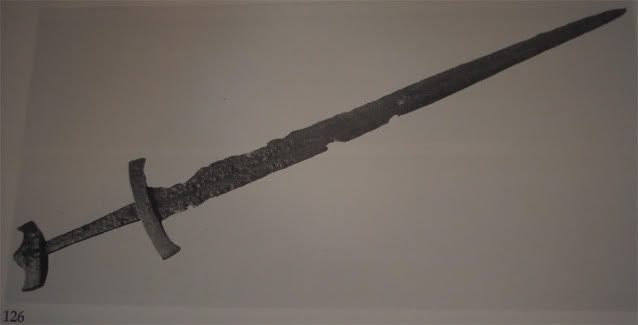
Oakeshott type E / Geibig type 19:

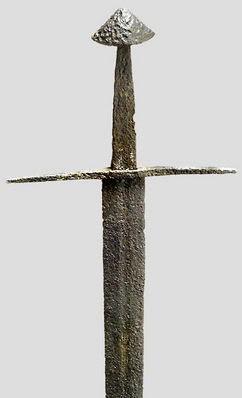
Oakeshot types N and O / Geibig types 17v.I and 17v.II:
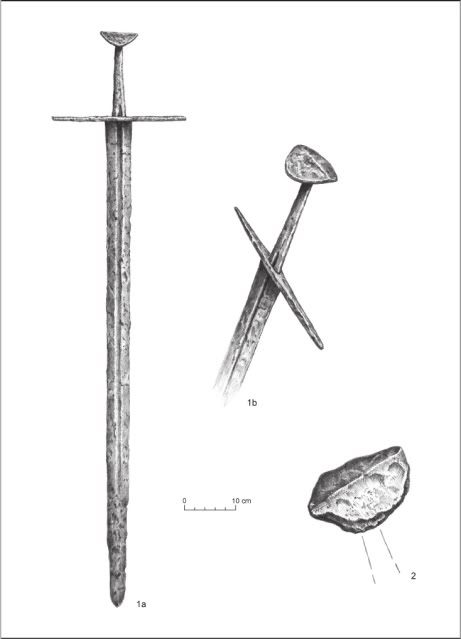
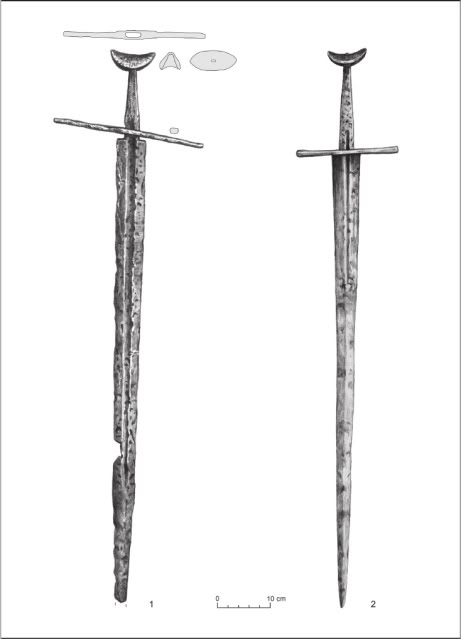
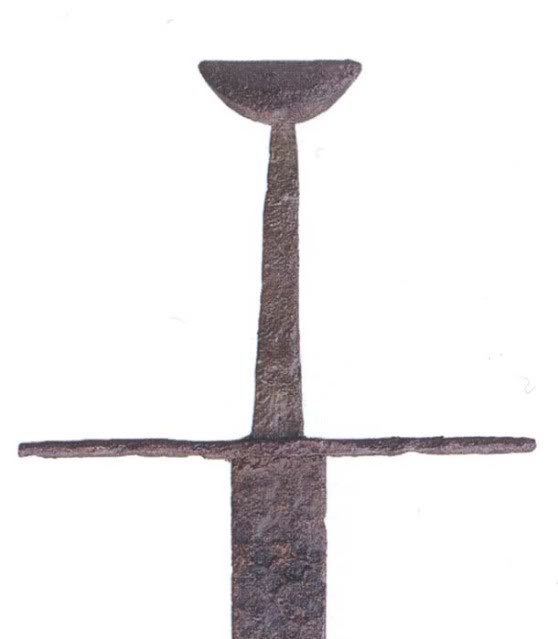
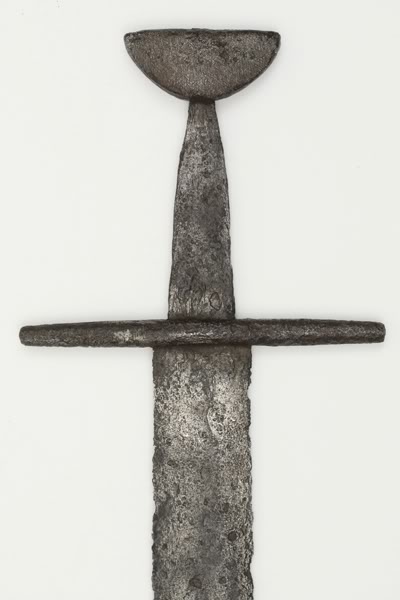

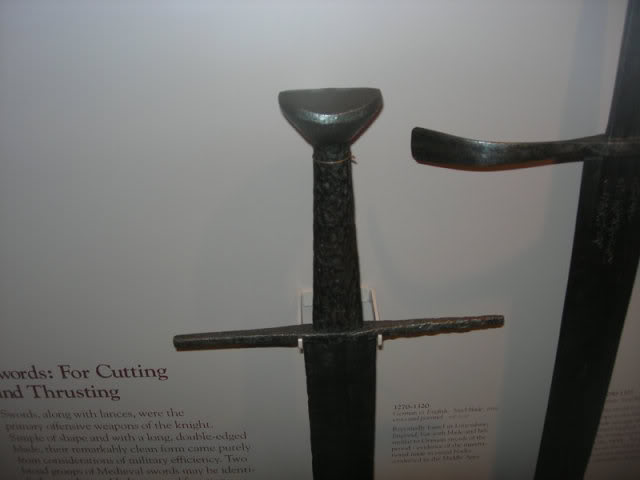
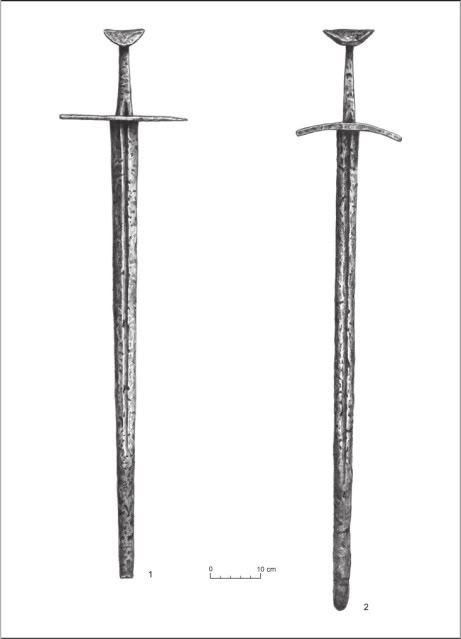

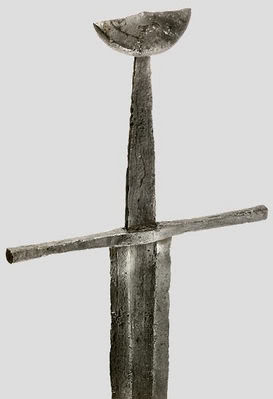

|
|
  |
 |
|
Tim Lison
|
 Posted: Mon 13 Jun, 2011 11:00 pm Post subject: Posted: Mon 13 Jun, 2011 11:00 pm Post subject: |
 |
|
|
Thanks for this Luka, I thouroughly enjoyed it! I think it really shows how fuzzy the lines are when trying to date swords by form. This type seems especially tough as it was popular for a long time. I can't shed much light on the Geibig dating as the access to information I have is also here on myArmoury. I can say that brazil nuts are one of my favorite types as well! Reading this and looking at the pictures makes me want to commisson a brazil nut sword or two...
|
|
  |
 |
|
Russ Mitchell
Location: Irving, TX Joined: 01 Mar 2004
Posts: 51
|
 Posted: Tue 14 Jun, 2011 8:48 am Post subject: Posted: Tue 14 Jun, 2011 8:48 am Post subject: |
 |
|
Truly massive B/14's are common on swords in 13th-century Hungary, attached to swords with very long blades and single-handed grips. Imagine four or five inches tacked onto a sword like the St. Maurice job, and you get an idea. If I ever get the funds for custom work I'll have one done just to see what that kind of lever arm does.
10,000 lemmings can't be wrong.
|
|
   |
 |
|
Scott Woodruff
|
 Posted: Tue 14 Jun, 2011 10:44 pm Post subject: Posted: Tue 14 Jun, 2011 10:44 pm Post subject: |
 |
|
|
Indeed Luka, most informative. I especially appreciate the different views, giving a better idea of the 3-dimensional shapes of the pommels. Rus, you wouldn't happen to know where I could find some pictures of the extra-long Hungarian Geibig 14's? I am really into extra-long 1-handers. I am currently working on a single-hander with a 90cm blade, but I could imagine going a bit longer!
|
|
  |
 |
Luka Borscak

|
 Posted: Wed 15 Jun, 2011 4:25 am Post subject: Posted: Wed 15 Jun, 2011 4:25 am Post subject: |
 |
|
Thanks guys, I hope one of our experts here will come and say something about this...
Btw, I would also love to see those long Hungarian swords, they are my neighbors... 
|
|
  |
 |
|
Scott Woodruff
|
 Posted: Wed 15 Jun, 2011 6:20 pm Post subject: Posted: Wed 15 Jun, 2011 6:20 pm Post subject: |
 |
|
|
I found a few bits of info in Baltu Kalavijai by Vytautus Kazakevicius that may interest you. He dates the "saddle-shaped" pommel coresponding to type N to 1175-1250 in western Europe. According to Ruttkay, this type dates from the 2nd half of the 12th to the 14th century in central Europe and according to Kirpichnikov it was used in eastern Europe throughout the 12th century into the 1st half of the 13th. Bruhn-Hoffmeyer dates the "rhomboidal" pommel (the illustration resembles the Geibig type 16v.1) to 1100-1250. Kirpichnikov dates this type to the 12th-13th centuries in eastern Europe. This data makes it seem to me like the brazil-nut pommel originated in western Europe at about the same time that the type N originated in eastern Europe and that as one spread west the other spread east. Of course taken as a whole including all the types the situation is much more complex. One more thing, all of the early eastern European type N's have really short guards, less than 11cm.
|
|
  |
 |
Luka Borscak

|
 Posted: Thu 16 Jun, 2011 3:59 am Post subject: Posted: Thu 16 Jun, 2011 3:59 am Post subject: |
 |
|
|
This about N is interesting. Most of N swords Marko Aleksić wrote about in his article are obviously from the same family, large bastard swords, N pommels, long crossguards, long blades of Xa, XIIa or XIII and XIIIa shape, obviously made during the short time somewhere in south Germany. A few N swords from his article are a bit different and don't seem to belong to the ones made in that same workshop as the big bastard N swords. And now it seems These bastard N swords from Germany are just a small family in a big community of N swords, and a family which appeared quite late in the N community, if N swords originated in the east Europe as early as 1100... I downloaded the Kazakevicius book when you gave me the link, but I didn't have time to read the english parts, I will have to obviously...
|
|
  |
 |
|
Scott Woodruff
|
 Posted: Thu 16 Jun, 2011 8:07 am Post subject: Posted: Thu 16 Jun, 2011 8:07 am Post subject: |
 |
|
|
Look at pages 78-85 and 140-141. Baltu Kalavijai is an amazing book and has completely changed my understanding of European swords. According to page 141, there are even some "saddle-shaped" pommels from the 11th century!
|
|
  |
 |
J.D. Crawford

|
 Posted: Fri 17 Jun, 2011 2:05 pm Post subject: Posted: Fri 17 Jun, 2011 2:05 pm Post subject: |
 |
|
I also like the Geibig system as it seems to be more objective. Unfortunately its hard to get that book in North America and even with a copy in hand I'd need a translater.  Oakeshott, for all his greatness, often contradicts himself and has certain biases that tend to create confusion. For example, in his early work he tries to draw a clear distinction between earlier 'Pagan' swords and medieval 'Christian' sword typologies, resulting on odd statements like B appearing later than A. Then he shows B and B1 swords like Figs 4 and 5 in SAC which he dates to 950. My favorite depiction of the historical appearance of Brazil Nut pommels is the timeline figure in the introduction of Ian Pierce's book which puts them in context of Petersen's typology, and shows B1 as a continuous simplification of earlier viking forms. My other theories of Brazil Nut progression are here, http://www.myArmoury.com/talk/viewtopic.php?t=21804, which I know you guys have already seen. Oakeshott, for all his greatness, often contradicts himself and has certain biases that tend to create confusion. For example, in his early work he tries to draw a clear distinction between earlier 'Pagan' swords and medieval 'Christian' sword typologies, resulting on odd statements like B appearing later than A. Then he shows B and B1 swords like Figs 4 and 5 in SAC which he dates to 950. My favorite depiction of the historical appearance of Brazil Nut pommels is the timeline figure in the introduction of Ian Pierce's book which puts them in context of Petersen's typology, and shows B1 as a continuous simplification of earlier viking forms. My other theories of Brazil Nut progression are here, http://www.myArmoury.com/talk/viewtopic.php?t=21804, which I know you guys have already seen.
|
|
   |
 |
|
Scott Woodruff
|
 Posted: Fri 17 Jun, 2011 8:35 pm Post subject: Posted: Fri 17 Jun, 2011 8:35 pm Post subject: |
 |
|
|
I would love to get my hands on Geibig's book. I am currently trying to learn German and doing a translation would be great practice. As to Oakeshott, I wonder what makes A "pagan" and B "christian". Is their any reason to think that religious changes had an impact on changing sword typologies?
|
|
  |
 |
J.D. Crawford

|
 Posted: Sat 18 Jun, 2011 3:16 am Post subject: Posted: Sat 18 Jun, 2011 3:16 am Post subject: |
 |
|
| Scott Woodruff wrote: | | I would love to get my hands on Geibig's book. I am currently trying to learn German and doing a translation would be great practice. As to Oakeshott, I wonder what makes A "pagan" and B "christian". Is their any reason to think that religious changes had an impact on changing sword typologies? |
I wouldn't say that Oakehsott ever directly said A was Pagan - for example an early fine example he liked to show from art was the arms bearer from the Gospels of Otto III 983-991, e.g. Fig. 8 in SAC.
The fundamental awkwardness of Oakeshott's typology is that he adopted sword types I-IX from wheeler's typology of viking swords based on pommel types, and then his switches to X based on blade types. He was trying to create a clear distinction between the existing Viking typologies and his new Medieval typology. But this is bound to create confusion - for example wheeler's XIII is brazil nut and IX is cocked hat, which also appear on Oakehsott sword types X-XIII as pommels A, B, C.
This early attempt to have a clear Viking-Medieval distinction created confusion for Oakeshott himself. For example there are a couple of surviving swords with XII blades and B1 pommels (e.g., Fig. 14 SAC). He was not sure whether to call this an X (because it looked Viking) or an XII (because that was the blade type). Later in his carreer he got rid of these biases and realized that there is no line between Viking and Medieval when it comes to blade types (its important to read the appendices added to later versions of his early works). However, his earlier work remains in print, many people might overlook the appendices, and we are still stuck with a blade typology that starts at X.
Geibig's scheme is limited in historical scope, but it happens to cover the age that interests some of us, and it's based on numbers and defineable geometry rather than intuition, so there's lots to be said for it. Just wish it was more accessible.
|
|
   |
 |
Luka Borscak

|
 Posted: Sat 18 Jun, 2011 3:21 am Post subject: Posted: Sat 18 Jun, 2011 3:21 am Post subject: |
 |
|
|
Just a guess, but maybe swords with A pommels more often had for example +VLFBERHT+ or INGELRII or LEUTERIT inscriptions and swords with B pommels INOMINEDOMINI or SOS inscriptions...
|
|
  |
 |
|
Scott Woodruff
|
 Posted: Sat 18 Jun, 2011 9:53 am Post subject: Posted: Sat 18 Jun, 2011 9:53 am Post subject: |
 |
|
|
My question about A and B pommels was somewhat facetious, but thank you for sharing your thoughts. It may be worthwhile to see if there is any correlation between pommel types and inscriptions.
|
|
  |
 |
Paul Hansen

|
 Posted: Thu 23 Jun, 2011 1:06 pm Post subject: Posted: Thu 23 Jun, 2011 1:06 pm Post subject: |
 |
|
Attached you'll find a scan of Geibig page 151 with an overview of his hilt types with chronology.
Two pages further, there is an overview of his blade types with chronology, so I've attached that one as well. 
Because his work is very, very thorough, it is not so easy to fully grasp. And I must admit to not really having had the time to really go into depth with it.
Both images copyright Alfred Geibig / Karl Wachholz Verlag, 1991. I hope it's ok to post them here, in an unaltered state. Otherwise, please let me know, then I'll delete them.
 Attachment: 126.78 KB Attachment: 126.78 KB
[ Download ]
 Attachment: 112.61 KB Attachment: 112.61 KB
[ Download ]
|
|
  |
 |
J.D. Crawford

|
 Posted: Thu 23 Jun, 2011 2:56 pm Post subject: Posted: Thu 23 Jun, 2011 2:56 pm Post subject: |
 |
|
|
Thanks for the images. If I'm reading this right, he puts his type 12 pommel (similar to Oakeshott's B) from 950-1100, and type 15 (similar to Oakeshott's A) from 1050-1275. Right? That sounds right to me.
|
|
   |
 |
Luka Borscak

|
 Posted: Sat 25 Jun, 2011 4:23 pm Post subject: Posted: Sat 25 Jun, 2011 4:23 pm Post subject: |
 |
|
|
Thanks Paul! I didn't have time to go through this yet but it will be very helpful to me...
|
|
  |
 |
Luka Borscak

|
 Posted: Mon 27 Jun, 2011 5:06 pm Post subject: Posted: Mon 27 Jun, 2011 5:06 pm Post subject: |
 |
|
| J.D. Crawford wrote: | | Thanks for the images. If I'm reading this right, he puts his type 12 pommel (similar to Oakeshott's B) from 950-1100, and type 15 (similar to Oakeshott's A) from 1050-1275. Right? That sounds right to me. |
I interpreted it as 950-1175, if the first column is 8th century, and last one is 13th century...
Btw, Paul, could you maybe post a picture of pommel types? In the myArmoury article is obviously a shortened version and not all variants are pictured...
|
|
  |
 |
Kirk Lee Spencer

|
 Posted: Mon 27 Jun, 2011 8:46 pm Post subject: Posted: Mon 27 Jun, 2011 8:46 pm Post subject: |
 |
|
| Luka Borscak wrote: | | J.D. Crawford wrote: | | Thanks for the images. If I'm reading this right, he puts his type 12 pommel (similar to Oakeshott's B) from 950-1100, and type 15 (similar to Oakeshott's A) from 1050-1275. Right? That sounds right to me. |
...Btw, Paul, could you maybe post a picture of pommel types? In the myArmoury article is obviously a shortened version and not all variants are pictured... |
Hey Luka...
You may be interested in this thread...
http://www.myArmoury.com/talk/viewtopic.php?t=14152
Skip down to the Geibig charts. There are quite a few... and if you copy them all into a folder, sort by name then do a slide show, you can almost see the organic nature of how the pommel changes through time.
In each chart, I tried to combine as much info on assiciations of blade, pommel and guard in Geibig's data. Also the dates Geibig gives are in blue for each of the groups.
ks
Two swords
Lit in Edenís flame
One of iron and one of ink
To place within a bloody hand
One of God or one of man
Our souls to one of
Two eternities
|
|
  |
 |
|
|
You cannot post new topics in this forum
You cannot reply to topics in this forum
You cannot edit your posts in this forum
You cannot delete your posts in this forum
You cannot vote in polls in this forum
You cannot attach files in this forum
You can download files in this forum
|
All contents © Copyright 2003-2025 myArmoury.com — All rights reserved
Discussion forums powered by phpBB © The phpBB Group
Switch to the Basic Low-bandwidth Version of the forum
|

